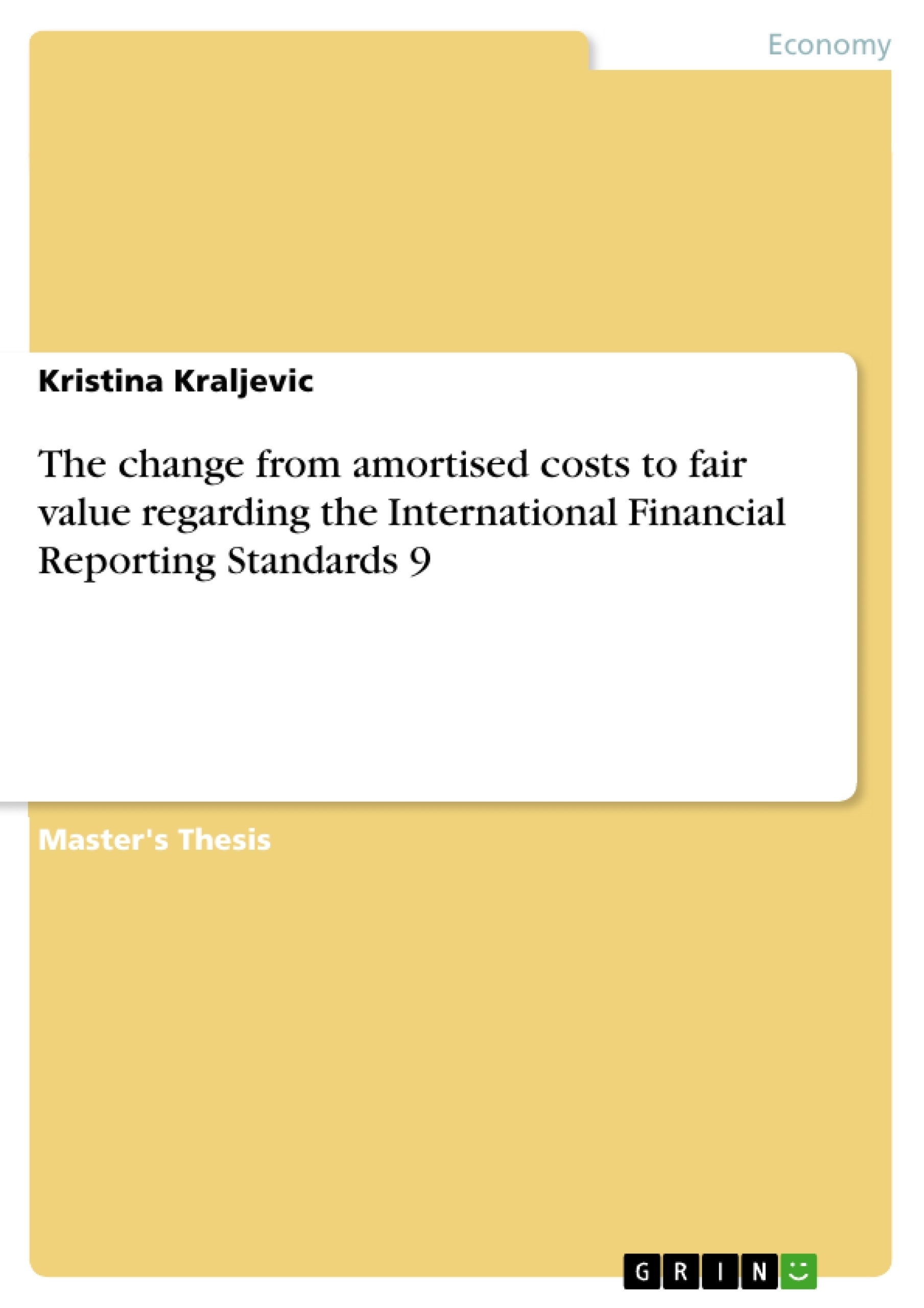This paper examines the adaption of the International Financial Reporting Standards 9, effective as of 1 January 2018. The introduction outlines the reasons for the amendments and the objectives of IFRS 9 which are divided into three phases. The focus of this paper is the effect of IFRS 9 on financial liabilities. While the International Accounting Standards 39 for financial liabilities are still accurate, IFRS 9 lead to a change in the fair value option. As a result, changes in the fair value which are caused by the own credit risk are booked into the other comprehensive income.
This paper aims to give an overview on the relevant changes regarding IFRS 9. However, the main focus is set at the liabilities side, the classification and the measurement of financial liabilities. Although the IASB intended to create a model in order to classify financial instruments of both the asset and the liabilities side, it had to prioritise the asset side owing to the financial crisis and the demand for new regulations in 2009. Therefore, the research context considers the adjustment of the fair value option (FVO) treatment. Due to the new regulation, changes in the own credit spread or rather the creditworthiness need to be captured under the position “other comprehensive income” (OCI), which affects the net income. Unless the financial liability is designated as FVO, the subsequent measurement of the liability follows amortised cost.
However, choosing the FVO implies that once the change in the credit spread has been recorded under the OCI, the amount is not reclassified into the profit-and-loss account (P & L). In contrast to that, a reclassification is permitted within equity e.g. a financial liability designated at FVO that is derecognised. The reason for the new regulation is based on IAS 39 and the measurement of liabilities in regard to the credit spread. Although, the creditworthiness deteriorated during the financial crisis, financial institutions had to realise the increasing credit spread in the P & L as an earning and a decreasing fair value (FV) of the liability. This mixed-model approach is a reason for the volatility in P & L’s and has been revised in the course of the IFRS 9.
Inhaltsverzeichnis (Table of Contents)
- 1 Introduction
- 1.1 Research interest & Research question
- 1.2 Objective of the examination
- 1.3 Relevance
- 1.4 Current state of research
- 2 Description of the methodical approach
- 3 International Financial Reporting Standards 9
- 3.1 Principles of the International Financial Reporting Standards Framework
- 3.2 Main amendments
- 3.2.1 Phase I Classification and Measurement
- 3.2.2 Phase II - Amortised Cost and Impairment
- 3.2.3 Phase III - Hedge Accounting
- 3.3 Valuation, classification and measurement under IFRS 9 and IAS 39
- 3.3.1 Financial Assets
- 3.3.2 Financial Liabilities
- 4 Balance Sheet and Profit-and-Loss Account
- 4.1 Asset Liability Management
- 4.1.1 Individual consideration of the profit-and-loss account
- 4.1.2 Overall view of the balance sheet
- 4.2 Risk Management
- 5 Banking products on the liability side and annual statement analysis
- 5.1 Deposits from customers
- 5.1.1 Terms and conditions
- 5.1.2 Influencing factors and impact factors
- 5.1.3 Measurement
- 5.2 Deposits from banks
- 5.2.1 Terms and conditions
- 5.2.2 Influencing factors and impact factors
- 5.2.3 Measurement
- 5.3 Own issuance
- 5.3.1 Terms and conditions
- 5.3.2 Influencing factors and impact factors
- 5.3.3 Measurement
- 5.4 Annual statement analysis
- 5.4.1 Raiffeisen Bank International Aktiengesellschaft
- 5.4.1.1 Deposits from customers
- 5.4.1.2 Deposits from banks
- 5.4.1.3 Own issuance
- 5.4.2 Erste Group Bank Aktiengesellschaft
- 5.4.2.1 Deposits from customers
- 5.4.2.2 Deposits from banks
- 5.4.2.3 Own issuance
- 5.5 Summary of the main differences between RBI AG and Erste Group AG
Zielsetzung und Themenschwerpunkte (Objectives and Key Themes)
This master's thesis examines the implementation of International Financial Reporting Standards 9 (IFRS 9), effective January 1, 2018, focusing on its impact on financial liabilities. The study aims to analyze the changes introduced by IFRS 9, particularly concerning the fair value option and its implications for financial reporting.
- Impact of IFRS 9 on financial liabilities
- Changes in fair value accounting under IFRS 9
- Comparison of IFRS 9 with IAS 39
- Application of IFRS 9 in practice (using case studies)
- Implications for asset liability management and risk management
Zusammenfassung der Kapitel (Chapter Summaries)
1 Introduction: This chapter introduces the research interest and question, outlining the objectives and relevance of the study concerning IFRS 9 and its impact on financial reporting. It also provides a review of existing literature on the topic.
2 Description of the methodical approach: This chapter details the research methodology employed in the thesis, explaining the methods used to analyze the impact of IFRS 9 on financial liabilities and to compare IFRS 9 with IAS 39. This section also discusses the case study approach and the selection of the specific banks analyzed.
3 International Financial Reporting Standards 9: This chapter provides a detailed overview of IFRS 9, explaining its principles and main amendments, particularly concerning the three phases of its implementation (Classification and Measurement, Amortised Cost and Impairment, and Hedge Accounting). The chapter compares and contrasts the valuation, classification, and measurement requirements of IFRS 9 and IAS 39 for both financial assets and liabilities, highlighting key differences and their potential impact on financial statements.
4 Balance Sheet and Profit-and-Loss Account: This chapter analyzes the impact of IFRS 9 on the balance sheet and profit-and-loss account. It examines the effects on asset liability management and risk management, explaining how the new standard changes reporting requirements and the subsequent implications for financial institutions. It specifically explores the implications for the presentation of financial liabilities on the balance sheet and the impact on profit and loss from changes in fair value.
5 Banking products on the liability side and annual statement analysis: This chapter delves into the practical application of IFRS 9 by analyzing the annual statements of Raiffeisen Bank International Aktiengesellschaft and Erste Group Bank Aktiengesellschaft. It examines different banking products on the liability side (deposits from customers, deposits from banks, and own issuances), detailing the terms and conditions, influencing factors, measurement methods under IFRS 9, and compares the reporting approaches of the two banks in detail.
Schlüsselwörter (Keywords)
IFRS 9, IAS 39, fair value, amortised cost, financial liabilities, financial reporting, fair value option, other comprehensive income, asset liability management, risk management, banking products, annual statement analysis.
Frequently Asked Questions: Master's Thesis on IFRS 9 Impact on Financial Liabilities
What is the main topic of this master's thesis?
This master's thesis examines the implementation of International Financial Reporting Standards 9 (IFRS 9), effective January 1, 2018, focusing on its impact on financial liabilities. It analyzes the changes introduced by IFRS 9, particularly concerning the fair value option and its implications for financial reporting.
What are the key objectives of the research?
The study aims to analyze the impact of IFRS 9 on financial liabilities, the changes in fair value accounting under IFRS 9, and a comparison of IFRS 9 with IAS 39. It also explores the practical application of IFRS 9 through case studies and examines its implications for asset liability management and risk management.
What is the structure of the thesis?
The thesis is structured into five chapters. Chapter 1 introduces the research question and objectives. Chapter 2 describes the research methodology. Chapter 3 provides a detailed overview of IFRS 9, including its principles and amendments. Chapter 4 analyzes the impact of IFRS 9 on the balance sheet and profit-and-loss account. Chapter 5 examines the practical application of IFRS 9 through an analysis of the annual statements of Raiffeisen Bank International Aktiengesellschaft and Erste Group Bank Aktiengesellschaft, focusing on banking products on the liability side.
Which specific banking products are analyzed in the thesis?
The thesis analyzes deposits from customers, deposits from banks, and own issuances as banking products on the liability side. It details the terms and conditions, influencing factors, and measurement methods under IFRS 9 for each product.
What specific banks are used as case studies?
The annual statements of Raiffeisen Bank International Aktiengesellschaft and Erste Group Bank Aktiengesellschaft are analyzed to illustrate the practical application of IFRS 9.
How does the thesis compare IFRS 9 and IAS 39?
The thesis compares and contrasts the valuation, classification, and measurement requirements of IFRS 9 and IAS 39 for both financial assets and liabilities, highlighting key differences and their potential impact on financial statements. This comparison is crucial for understanding the changes introduced by IFRS 9.
What are the key themes explored in the thesis?
Key themes include the impact of IFRS 9 on financial liabilities, changes in fair value accounting, a comparison with IAS 39, practical application through case studies, and implications for asset liability management and risk management.
What are the key words associated with this thesis?
IFRS 9, IAS 39, fair value, amortised cost, financial liabilities, financial reporting, fair value option, other comprehensive income, asset liability management, risk management, banking products, annual statement analysis.
What is the methodology used in this research?
The thesis details the research methodology employed, explaining the methods used to analyze the impact of IFRS 9 on financial liabilities and to compare IFRS 9 with IAS 39. It also discusses the case study approach and the selection of the specific banks analyzed.
What is the overall conclusion of the thesis (in general terms)?
The thesis aims to provide a comprehensive understanding of the implementation and impact of IFRS 9 on financial liabilities within the banking sector, offering insights into practical application and the implications for financial reporting and risk management. Specific conclusions regarding the comparison of the two banks are presented within chapter 5.
- Citation du texte
- Kristina Kraljevic (Auteur), 2019, The change from amortised costs to fair value regarding the International Financial Reporting Standards 9, Munich, GRIN Verlag, https://www.grin.com/document/901784




